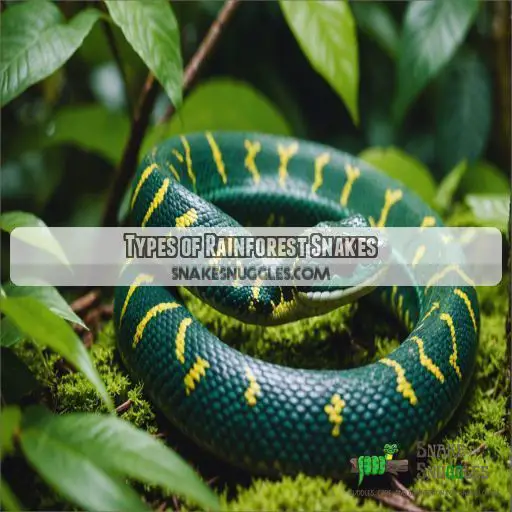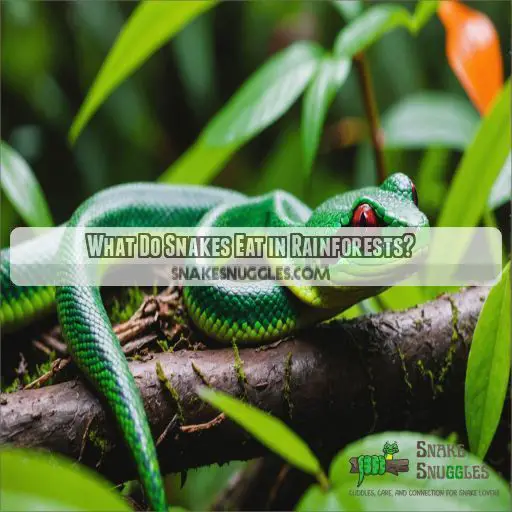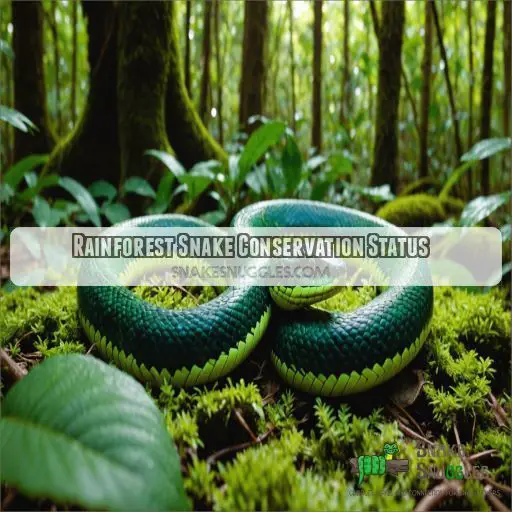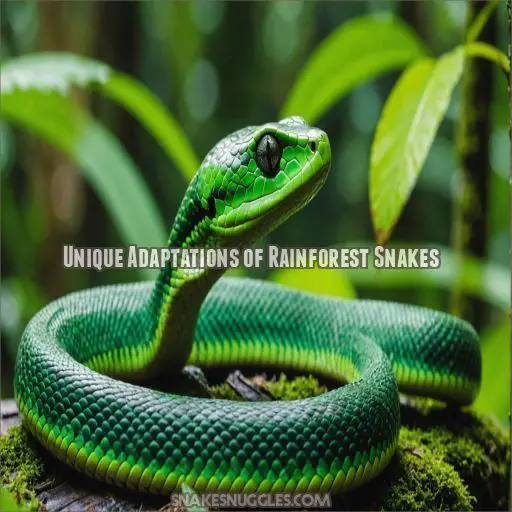This site is supported by our readers. We may earn a commission, at no cost to you, if you purchase through links.
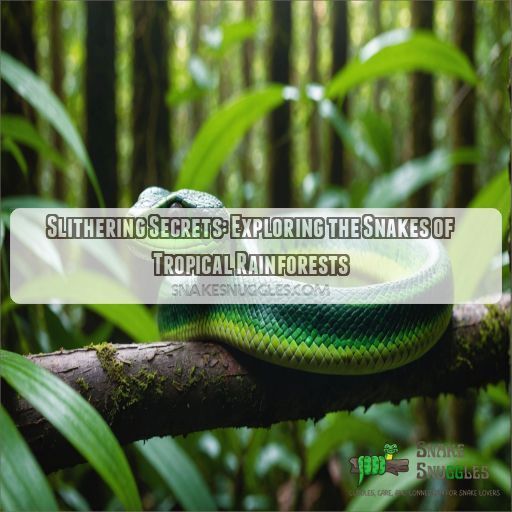
These slithering superstars have adapted magnificently to thrive in this warm, humid habitat.
Whether they’re gliding gracefully through the canopy or lurking in the undergrowth, rainforest snakes have mastered the art of camouflage and stealth.
From the powerful constricting abilities of pythons to the venomous fangs of coral snakes, these reptiles play a key role in the rainforest ecosystem. Coral snake look-alikes are often mistaken for the real deal, but understanding the subtle differences in their patterns can help avoid a potentially dangerous encounter.
Table Of Contents
- Key Takeaways
- Types of Rainforest Snakes
- Rainforest Snake Habitats and Adaptations
- What Do Snakes Eat in Rainforests?
- Rainforest Snake Conservation Status
- Unique Adaptations of Rainforest Snakes
- Rainforest Snakes and Their Role in the Ecosystem
- Why Protecting Rainforests is Crucial for Snakes
- Frequently Asked Questions (FAQs)
- Where do snakes live in the rainforest?
- What is the habitat of a snake?
- What do snakes eat in rainforests?
- How much snakes are in the rainforest?
- How do rainforest snakes camouflage against predators?
- Are rainforest snake species threatened by climate change?
- Do rainforest snakes interact with indigenous communities?
- What are the breeding behaviors of rainforest snakes?
- How do rainforest snakes adapt to seasonal changes?
- Conclusion
Key Takeaways
- You’ll discover that rainforest snakes live everywhere from treetops to the forest floor, embracing their ninja-like abilities to blend in with the surroundings. Their survival depends on being invisible as both hunters and the hunted in this vibrant, bustling jungle.
- Adaptation is their middle name – whether they’re gliding through the air like a slithery trapeze artist or using their heat-sensing pits to locate dinner, snakes have evolved to be the masters of their humid, leafy home.
- Rainforest snakes are under threat from climate change and habitat loss, and they rely on our conservation efforts to keep their leafy abodes from disappearing. Supporting these initiatives is crucial to ensure their historical presence continues on.
- You might think of snakes as nature’s undercover agents, keeping the rainforests balanced by regulating prey populations. Without them, the jungle rhythm would be as offbeat as a song missing its bass line.
Types of Rainforest Snakes
In the bustling, vibrant world of tropical rainforests, snakes of all shapes and sizes navigate their lush habitats, from slinky pythons and powerful anacondas to stealthy vipers and agile tree gliders. Whether they’re basking on a branch or slithering through the underbrush, these fascinating reptiles have adaptations that’d make a superhero jealous!
Pythons and Boa Constrictors
Pythons and boa constrictors are the heavyweights of the rainforest! They’re not just big but use their size to their advantage. Here’s the lowdown on them:
- Size comparison: Boas often reach impressive lengths, but pythons can grow even longer.
- Hunting methods: Both squeeze their prey to catch dinner.
- Habitat differences: Adapt magnificently to rainforest floors and trees.
Don’t underestimate their gripping skills!
Anacondas and Other Large Snakes
After exploring the impressive pythons and boa constrictors, turn your gaze to the hefty anacondas. These snakes, the true titans of tropical rainforests, can weigh over 550 pounds and embody the phrase "size matters" . They lurk in water, exhibiting behaviors like ambush hunting. Threats such as deforestation urge further conservation efforts for these giant nonvenomous reptiles .
Venomous Snakes in Rainforests
While anacondas are all about size, venomous snakes add flair to rainforests.
Picture the iconic cobra or the elusive black mamba—their venom evolution is a scientific marvel.
They’re like nature’s chemists, sparking antivenom development and snakebite treatment advances.
Each snake species, from the Gaboon viper to the coral snake, plays a vivid role in the cultural tapestry of rainforest animals.
Nonvenomous Snakes in Rainforests
While venomous snakes may steal the spotlight, the rainforest is also home to a diverse array of nonvenomous snakes. These gentle giants include:
- Constrictors like boas and pythons that kill prey by squeezing.
- Snakes with excellent camouflage, blending seamlessly into the lush foliage.
- Generalist feeders that dine on a variety of small animals.
- Nonvenomous species that mimic the appearance of their venomous counterparts for protection.
Snakes With Unique Adaptations
You’re curious about nonvenomous rainforest snakes, and they’re full of surprises!
Imagine a flying snake gliding gracefully through the canopy.
These acrobats twist their bodies into a C-shape to catch air.
Meanwhile, camouflage wizards like the bamboo pit viper blend seamlessly into their surroundings.
Others rely on heat-sensing pits or prehensile tails, each adaptation lighting up this lush jungle stage.
Rainforest Snake Habitats and Adaptations
Tropical rainforests provide the perfect habitat for snakes to thrive, offering the warmth, humidity, and abundant prey these cold-blooded reptiles need to survive. From the forest floor to the treetops, rainforest snakes have evolved a range of ingenious adaptations to navigate this lush, verdant world. (Source)
Tropical Rainforest Canopy and Forest Floor
While exploring tropical rainforests, you’ll notice the canopy and forest floor create distinct microclimates where snakes thrive.
The dense canopy shields the forest floor from harsh sunlight, creating a cool, humid habitat.
Amidst lush vegetation, snakes, adept in rainforest ecology, navigate their worlds.
Protecting these habitats, especially with climate change, makes sure snakes don’t become endangered species.
Who knew nature’s layering was so important?
Tree-Dwelling Snakes and Their Adaptations
Dancing through treetops, tree-dwelling snakes embrace their environment with camouflaged grace and branch-gripping scales. Moving through this leafy dance floor, these snakes thrive on their ability to blend seamlessly with the canopy.
- Green anaconda: Not just a floor hugger; sometimes, even a tree hugger!
- Reticulated python: Master of hide-and-seek in leafy greens.
- Boa constrictor: Constricts myths and prey alike.
Snakes With Prehensile Tails
In tropical rainforests, snakes with prehensile tails grip branches like acrobats. Imagine them using their tails for climbing, balancing, and even hunting. They navigate through trees with the ease of a gymnast.
| Snake | Tail for Climbing | Tail for Balance | Tail for Defense |
|---|---|---|---|
| King Cobra | Yes | Yes | Yes |
| Green Mamba | Yes | Yes | No |
| Burmese Python | Yes | Yes | No |
These tails are nature’s Swiss Army knives!
Camouflage and Coloration in Snakes
Deep within rainforests, snakes have mastered the art of disguise! Their camouflage and coloration may vary with the environment, enabling them to:
- Mimic leaves or branches to avoid predators.
- Display color-changing abilities in certain types.
- Utilize warning coloration to send a steer-clear message.
Nature’s own optical illusions, snakes are true masters of chameleon-like appearances!
Snakes That Live in Water
If you’re curious about rainforest snakes, you’ll find some fascinating species that love the wet life. These water-loving serpents, like the enigmatic water pythons, have unique adaptations to thrive in their aquatic habitats. They elegantly glide through water, showcasing traits like strong swimming abilities and flexible diets.
| Snake Species | Aquatic Adaptations | Water Snake Diet |
|---|---|---|
| Water Pythons | Streamlined bodies | Fish and amphibians |
| Coastal Taipan | Swift movements | Small mammals |
| Green Anaconda | Powerful swimmers | Large prey, like capybaras |
Their lives weave a rich tapestry of survival, echoing nature’s ingenuity.
What Do Snakes Eat in Rainforests?
Snakes in the tropical rainforest are true masters of their domain, with a diverse array of hunting strategies and prey preferences. From venomous serpents that subdue their quarry with potent toxins to powerful constrictors that squeeze the life out of their victims, these slithering predators play a key role in maintaining the delicate balance of the rainforest ecosystem. (Source)
Prey and Hunting Strategies
Imagine you’re a snake in the rainforest, blending into your surroundings.
Here, size and agility make you a master of ambush, surprising prey with finesse.
Whether you constrict them with a squeeze or quickly strike with stealth, your hunting strategies showcase the marvel of nature.
Snakes in rainforests eat everything from large mammals to tiny critters, each meal a reflection of evolution.
Venomous Snakes and Their Prey
Imagine encountering a venomous snake in the rainforest. These slithery predators have evolved incredible venom defenses, allowing them to expertly hunt. Here’s how they do it:
- Snake Venom Effects: Paralyzes prey quickly.
- Snake Hunting Techniques: Ambush tactics and stealthy maneuvers.
- Prey Adaptations: Some creatures develop resistances as a survival mechanism.
It’s a jungle out there!
Nonvenomous Snakes and Their Prey
When you’re talking nonvenomous snakes in rainforests, think about those artful constricting techniques they use. They coil around their prey, squeezing the life out of them with precision. Pretty intriguing, right? With varying prey sizes, hunting strategies become diverse while their brilliant snake camouflage keeps them stealthy. Here’s a glimpse:
| Aspect | Details |
|---|---|
| Constrictor Type | Boa Constrictors |
| Prey Size | Medium to Large |
| Habitat | Forest Floor, Trees |
| Camouflage Colors | Green, Brown |
| Food Chain Impact | Balances predator-prey |
Snakes That Eat Small Animals
Rainforest snakes come in all shapes and sizes, and their diets reflect this diversity. Smaller snakes often feast on rodents, frogs, lizards, and even insects – their agility and camouflage making them expert hunters of these abundant prey. 1) Quick strikes, 2) constriction, 3) venom, and 4) stealth help these snakes catch even the quickest critters.
Snakes That Eat Large Prey
You’ve seen snakes feast on small critters, now prepare for the big leagues! Some rainforest snakes, like anacondas and pythons, tackle large prey by using their relentless constrictor tactics. An anaconda might take down a capybara, showcasing its hefty anaconda diet. Imagine a python eyeing a deer! The prey size limits these snakes’ meals, yet their appetite always impresses.
Rainforest Snake Conservation Status
Imagine facing a world where apex predators are at risk; that’s the precarious reality rainforest snakes face due to habitat destruction and human activity (Source). If we don’t step in to protect these important creatures and their lush homes, we might find ourselves in a hiss-toric predicament without the mesmerizing biodiversity rainforests offer.
Threats to Rainforest Snakes
When snakes in rainforests grab their dinner, they face more than just their prey. Deforestation gives them the cold shoulder, reducing their cozy tree canopies and warm floors. Habitat loss, like theft of their snake castle, hurts them. Climate change cranks up the heat, while poaching and pollution pop up like unwanted guests crashing a party.
Endangered and Threatened Species
You’ll be saddened to learn that many rainforest snake species are now endangered or threatened due to habitat loss and poaching. These include the green anaconda, king cobra, and gaboon viper. To protect these slithering wonders, we must:
- Halt deforestation
- Crack down on illegal wildlife trade
- Implement robust conservation programs
- Address climate change impacts
Conservation Efforts and Organizations
You’ve just discovered the endangered rainforest snakes in need of saving.
So, what can you do?
Conservation organizations like Rainforest Rescue work their magic, advocating for sustainable practices to halt snake habitat loss.
They’re protecting rainforests, and these snakes count on you to join the cause.
After all, you wouldn’t abandon a friend in a tight spot, would you?
Protecting Rainforests and Snake Habitats
You’ve just read about conservation efforts, and now let’s talk about protecting rainforests and snake habitats. Deforestation impacts these slithering wonders by shrinking their homes, posing serious conservation challenges. Ecotourism benefits foster sustainable logging and empower local communities. Don’t let our rainforests disappear—ensure their freedom thrives for snakes and future generations. Let’s keep our planet’s lungs breathing!
Raising Awareness for Snake Conservation
Snake myths often overshadow their ecological importance.
Let’s face it: snakes aren’t out to get you but play an essential role in the ecosystem!
Raising awareness through education outreach helps debunk these myths.
Support conservation efforts and combat habitat loss by engaging in responsible tourism.
Every small action nudges us closer to a future where humans and snakes coexist peacefully.
Unique Adaptations of Rainforest Snakes
Rainforest snakes have evolved some truly remarkable adaptations to thrive in their lush, verdant habitats. From gliding through the air to sensing prey with specialized heat-detecting pits, these slithering creatures are masters of their domain.
Gliding Snakes in Southeast Asia
Ever seen a snake fly? Well, gliding snakes in Southeast Asia practically do! Using a unique gliding mechanism, these snakes soar from tree to tree. Their adaptations, including a flattened body, allow them to catch air like a paper airplane. Though they face threats like deforestation, conservation efforts aim to protect these incredible aerial acrobats and their prey selection habitat.
Snakes With Heat-Sensing Pits
As you swing from gliding snakes to those with heat-sensing pits, imagine these pit vipers. They’ve got built-in infrared goggles! Their heat-sensing pits detect warm-blooded prey, even in pitch-black darkness. It’s a leaf-blower’s dream come true! Snake senses are honed for hunting, hunting techniques, making them incredibly efficient predators. Evolution’s way of equipping pit vipers with the ultimate stalking gear in rainforests.
Snakes With Specialized Scales
Deep within rainforests, snakes sport specialized scales, quite like nature’s Swiss army knives. With scales for gripping, they dance nimbly among branches. Some boast scales for camouflage, blending seamlessly like chameleons. Gadgets for defense and movement make them masters of their domain. Scales for sensing enable them to feel vibrations, almost as if eavesdropping on nature’s whispers.
Snakes With Strong Constricting Abilities
Rainforest constrictors like boas and pythons have evolved powerful muscles that allow them to coil around and squeeze their prey until it suffocates. Their thick, muscular bodies can constrict animals much larger than themselves, from small rodents to deer. This incredible strength is a key adaptation for surviving in the lush, competitive rainforest.
Snakes With Bright Coloration
In the vibrant jungle, some snakes don striking hues for a reason. Their bright coloration serves as nature’s flashing neon sign: "Stay back!" These vivid colors often signal danger to predators, warning of venomous bites. Others use mimicry, pretending to be dangerous, or employ camouflage to blend in, creating a masterclass in predator defense artistry. Nature’s palette is fascinating!
Rainforest Snakes and Their Role in the Ecosystem
You’ll discover that snakes play vital roles in tropical rainforests, balancing nature’s complex web by being both hunters and hunted. They’re like the unsung heroes of the jungle, maintaining biodiversity and the overall health of their ecosystem.
Snakes as Predators and Prey
Snakes play dual roles as both predators and prey in the rainforest’s web of life.
Their snake hunting strategies rely on stealth, speed, and venom.
Meanwhile, prey adaptations like camouflage help evade these cunning hunters like green tree pythons.
The predator-prey balance shapes snake diets and keeps rainforest ecosystems as lively hubs of activity.
Snakes and the Balance of Nature
As guardians of the rainforest’s delicate balance, snakes play a key role in maintaining the ecosystem’s harmony. By regulating prey populations, they help create a thriving web of life. From controlling rodent numbers to managing insect populations, these slithering sentinels are the unsung heroes of the rainforest’s intricate dance.
- Snakes as natural pest control
- Snakes as keystone species
- Snakes and the cycle of life
- Snakes and the preservation of biodiversity
Snakes and the Food Chain
Ever wonder where snakes fit in the food chain? They’re key players, munching on various creatures. Snake diet relies on prey adaptations, using venom or constriction to nab a meal. As apex predators, they maintain balance, preventing any one prey population from taking over. Think of them as the silent regulators, ensuring peace in this vibrant ecosystem.
Snakes and the Web of Life
In the rainforest’s web of life, snakes play the role of both predator and prey, making them a key part of the ecosystem.
They balance the scales of life by controlling prey populations and providing food for larger predators.
Think of it like nature’s own version of your favorite detective show – a mysterious yet essential piece in the rainforest’s puzzle.
Snakes and the Importance of Biodiversity
Snakes play a major role in biodiversity in rainforests, embodying vibrant threads in nature’s tapestry. They maintain ecosystem balance by controlling prey populations. Imagine a jungle without them – it’s like a song missing its bass line. Their presence also signifies healthy habitats.
- Keystone predators managing pest control
- Indicators of ecosystem wellness
- Contributors to nutrient cycles
- Partners in biodiversity preservation
Why Protecting Rainforests is Crucial for Snakes
Tropical rainforests are the lifeblood of countless snake species, providing the ideal habitat and resources they need to thrive. Protecting these lush, biodiverse ecosystems is essential for ensuring the long-term survival of snakes and maintaining the delicate balance of nature.
Rainforests and Climate Regulation
Rainforest snakes play a key role in nature’s intricate tapestry by maintaining balance. But when rainforest deforestation rears its ugly head, snakes face climate change impacts too. Their habitats, like tangled threads, unravel, leading to biodiversity loss. Rainforests act as Earth’s carbon sequestration superheroes, stabilizing climates.
| Key Factor | Rainforests’ Role |
|---|---|
| Climate Regulation | Carbon Sequestration |
| Snake Survival | Habitat Preservation |
| Biodiversity Balance | Protecting Ecosystems |
Rainforests and Oxygen Production
In rainforest discussions, you’ve probably pondered their role in climate regulation. But wait till you hear about oxygen production! Rainforests act like gigantic air purifiers, converting tons of carbon dioxide into oxygen. How’s that for multitasking? Here’s what they offer:
- Combat oxygen depletion
- Support tree diversity
- Mitigate climate change impact
Talk about Earth’s lungs doing all the heavy lifting!
Rainforests and Animal Habitats
Heading into rainforests reveals diverse animal habitats essential for snakes. These forests’ intricate ecosystems offer safety and freedom, balancing biodiversity and adaptation marvels.
| Feature | Role in Habitat |
|---|---|
| Canopy | Offers shade |
| Forest Floor | Hunting ground |
| Waterways | Hunting spot |
| Trees | Living space |
| Foliage | Camouflage |
Protecting these habitats combats human impact, preserving nature’s delicate web.
Rainforests and the Future of Snakes
Rainforests offer cozy homes for snakes and wonders for you, too! Imagine a world without mighty snakes to thrill snake tourism. Yet, climate change knocks at their door, shouting, "Habitat loss!" So, let’s fund conservation and snake research to keep their enchanting charm alive. Protect rainforests—it’s like guarding your backyard zoo!
- Snake tourism benefits
- Mitigating climate change impact
- Conservation funding urgency
- Counteracting habitat loss
- Promoting snake research
Frequently Asked Questions (FAQs)
Where do snakes live in the rainforest?
You’ll find snakes in rainforests both on the ground and up in the trees, enjoying the shady, cozy spots. They blend right in like nature’s ninjas, camouflaging while hunting tasty prey in this wild, vibrant jungle ecosystem.
What is the habitat of a snake?
Snakes are versatile renters, calling forests, deserts, grasslands, and even urban jungles home. They adapt cleverly to environments, relishing warm tropics, thriving in humidity and shadows, while their scales offer a stylish grip on life.
What do snakes eat in rainforests?
Imagine a buffet of rainforest critters: snakes dine on birds, lizards, and small mammals. Some even swallow frogs and fish whole! Adapted like nature’s perfect hunters, they’re always poised to pounce on their next meal.
How much snakes are in the rainforest?
Rainforests teem with a diverse array of snakes, from the massive anaconda to the nimble tree-dwelling species. While exact numbers vary, these lush habitats provide ample food and shelter for countless slithering residents. Get ready for some serious snake-spotting!
How do rainforest snakes camouflage against predators?
Rainforest snakes camouflage by blending in with their surroundings through mimicry, cryptic coloration, and patterns like stripes and bands. These tactics help them hide from predators and ambush prey. Remember, nature’s got snakes covered—literally! .
Are rainforest snake species threatened by climate change?
Rainforest snakes are indeed feeling the heat from climate change! Rising temperatures and habitat disruptions threaten their survival. It’s a slippery slope, but with conservation efforts, we can help these fascinating creatures continue to thrive in their leafy domains.
Do rainforest snakes interact with indigenous communities?
Did you know rainforest snakes slither into 80% of indigenous myths? These snakes affect daily life, providing food, medicinal uses, and spiritual significance. Embrace their key role but watch your step in those slippery tales!
What are the breeding behaviors of rainforest snakes?
Rainforest snakes employ various breeding strategies, from laying eggs to live birth, often influenced by their habitat’s temperature and humidity. Their courtship rituals are subtle, involving pheromone trails and gentle nudges—proving love is a slithery affair!
How do rainforest snakes adapt to seasonal changes?
Rainforest snakes adapt to seasonal changes with flexible behaviors like altering activity patterns; 6 out of 11 snakes show shifts due to seasonal habitat use. They’re like nature’s adaptable athletes, gracefully responding to environmental cues .
Conclusion
Picture the rainforest as a bustling city where snakes take on diverse roles from silent hunters to stealthy acrobats, each playing its part in this vibrant ecosystem.
You can appreciate their important role in sustaining life by connecting with these "citizens."
Though snake habitat in tropical rainforests faces many threats, you can help protect them by supporting conservation efforts.
Embrace the wonders of rainforest snakes as they gracefully navigate a world brimming with secrets and surprises.

